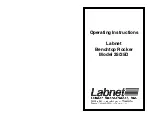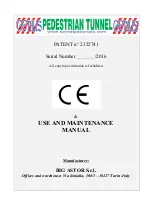
4. INSTALLATION
32
3. If the bracket has been temporarily fas-
tened to the transom, remove it. Apply a
marine sealant to the threads of the three
#10 x 1-1/4" self tapping screws to prevent
water seeping into the transom. Screw the
bracket to the hull. Do not tighten the
screws completely at this time.
4. Repeat step 1 to ensure that the angle of
the sensor is correct.
Note:
Do not position the sensor farther into
the water than necessary to avoid increasing
drag, spray, and water noise and reducing
boat speed.
5. Using the vertical adjustment space on the
bracket slots, slide the sensor up or down
to provide a projection of 3 mm (1/8”).
Tighten the screws.
Vertical adjustment and cable routing
Attaching the sensor to the bracket
1. If the retaining cover near the top of the
bracket is closed, open it by depressing the
latch and rotating the cover downward.
Attaching the sensor to the bracket
2. Insert the sensor's pivot arms into the slots
near the top of the bracket.
3. Maintain pressure until the pivot arms click
into place.
4. Rotate the sensor downward until the
bottom snaps into the bracket.
5. Close the retaining cover to prevent the
accidental release of the sensor when the
boat is underway.
Cable routing
Route the sensor cable over the transom,
through a drain hole, or thorough a new hole
drilled in the transom above the waterline.
Never cut the cable or remote the connector;
this will void the warranty. Always wear safety
goggles and a dust mask.
1. If a hole must be drilled, choose a location
well above the waterline. Check for
obstructions such as trim tabs, pumps, or
wiring inside the hull. Mark the location
with a pencil. Drill a hole through the tran-
som using a 19 mm or 3/4" bit (to accom-
modate the connector).
2. Route the cable over or through the
transom.
3. On the outside of the hull secure the cable
against the transom using the cable
clamps. Position a cable clamp 50 mm (2")
above the bracket and mark the mounting
hole with a pencil.
4. Position the second cable clamp halfway
between the first clamp and the cable hole.
Mark this mounting hole.
5. If a hole has been drilled in the transom,
open the appropriate slot in the transom
cable cover. Position the cover over the
cable where it enters the hull. Mark the two
mounting holes.
6. At each of the marked locations, use a 3
mm or 1/8" bit to drill a hole 10 mm (3/8")
deep. The prevent drilling too deeply, wrap
masking tape around the bit 10 mm (3/8")
from the point.
7. Apply marine sealant to the threads of the
#6 x 1/2" self-tapping screw to prevent
water from seeping into the transom. If you
have drilled a hole through the transom,
apply marine sealant to the space around
the cable where it passes through the
transom.
Cable cover
Cable
clamp
50 mm (2")
Hull projection 3 mm (1/8")
Step 1
Step 2
Latch
Pivot
arm (2)
Slot (2)
Retaining
cover
Step 3
Step 4
















































